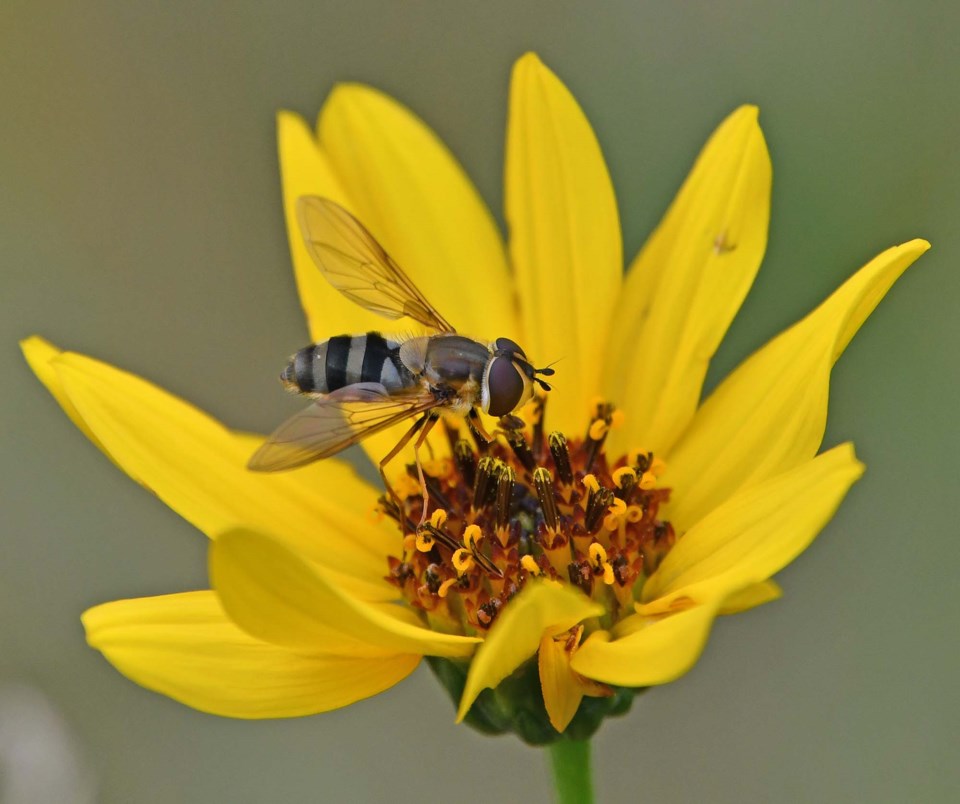Sturgeon County farmers should plant more trees around their canola to attract yield-boosting fake bees, recent research suggests.
University of Alberta PhD student Rachel Pizante published her study on trees, canola, and hoverflies in Agriculture, Ecosystems & Environment last August. The study examines what type of border drew the most hoverflies to a canola field: trees or grass.
A hoverfly is a fly that looks and acts like a bee, presumably to trick predators into thinking it has a deadly sting, Pizante said. (It doesn’t, but it does hover and collect pollen and nectar from flowers.) Hoverflies have two wings, compared to four for a bee, and have rounder, less angular heads.
“They almost look dorkier than bees,” she said, giving them a certain underdog’s charm.
Hoverflies are the main wild pollinator of canola in central Alberta, beating out any wild bee, Pizante said. While domestic honeybees (where present) and the wind are more important pollinators for canola, European research suggests farmers can see improved yields if they draw hoverflies to their fields. Other studies suggest hoverflies also provide pest control, as their larvae eat aphids and other insects.
Fake bees, real help
Pizante and her team wanted to see whether grasslands or treed areas drew more hoverflies to canola crops. To do so, they placed tent-like Malaise traps in grassy and treed borders around 10 canola fields in 2021 in central Alberta, including ones by Carbondale and Bon Accord. The traps had one opening facing the fields and the other facing the borders, allowing the team to track insect movements.
The traps collected some 2,175 hoverflies from 92 species, as well as a bunch of other bugs, Pizante said. Curiously, the traps did not catch any drone flies (known for the bands of hair on their eyes), despite them being the most common hoverflies in Alberta.
Pizante’s team found that treed borders exported a net 84,699 hoverflies/week/km to canola fields, or about 33 times more than the grassy areas sent to their fields. Treed areas also exported a more diverse array of hoverflies. This suggested that trees were better than grass for pollination, as trees encouraged hoverflies to stick around crops.
The team believed this difference happened because the treed areas were great habitats for hoverfly larvae but poor ones for adults. On growing up, those larvae would fly to the canola fields to feast on pollen and nectar. Only the pregnant females bothered to return to the forest to lay eggs, resulting in a net export of hoverflies. Grassy areas were pretty similar to canola fields, so hoverflies had no reason to favour one over the other.
Pizante’s team recommended that farmers maintain and plant treed borders around crops to get the most out of their hoverflies.
Murray Mulligan, who owns the Bon Accord farm featured in this study, said he wasn’t familiar with Pizante’s work and had never heard of hoverflies before she came along. He said he’d want to see more evidence before he started planting more trees around his canola fields.
Morinville-area farmer Ward Middleton, who reviewed this study at the Gazette’s request, said he was pleased to learn of this dramatic difference between treed and grass borders, and how hoverflies could both pollinate crops and eat pests. His farm had many natural and constructed treed shelterbelts, which provide habitat and travel corridors for many species.
“The more diverse and broader the shelterbelt is, the more diversity there is of species that exist and move in and reside in the shelterbelt,” he said.
Pizante’s study can be found at bit.ly/3zENLE7.



